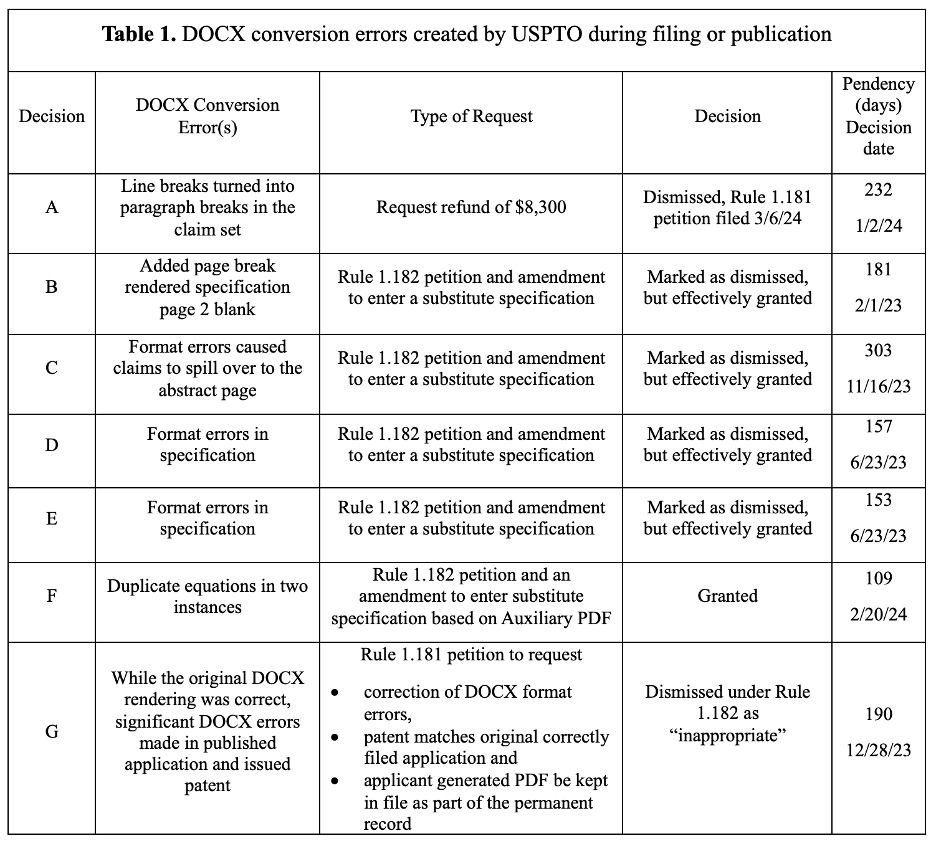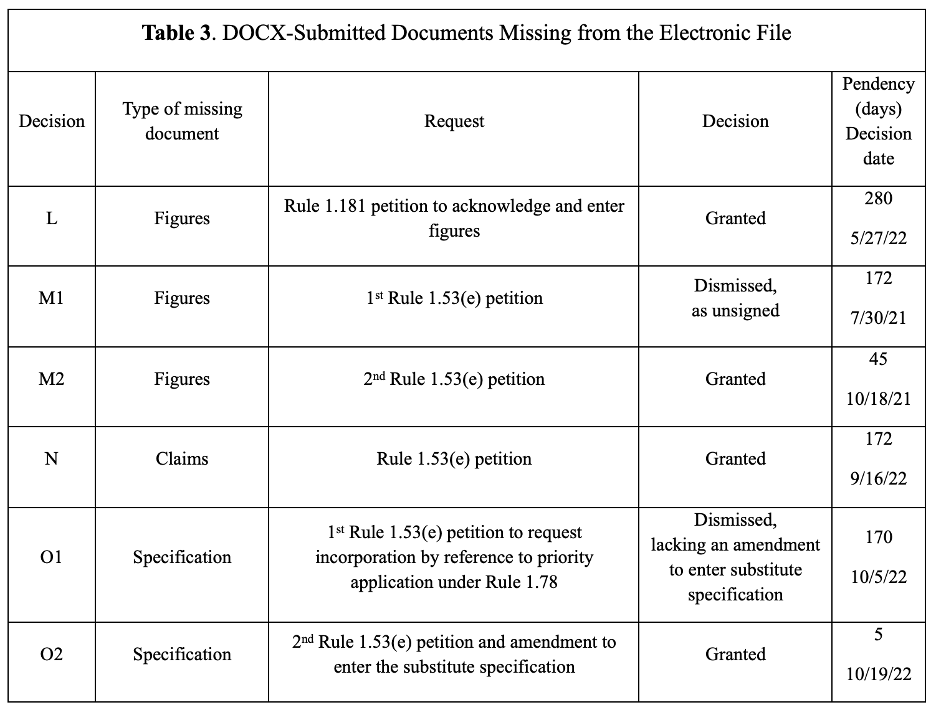“We discovered important delays within the processing of patent functions with precise or perceived (i.e., uploaded paperwork ‘lacking’ from the official file) DOCX-related errors.”
Just like Steve Martin and John Sweet’s calamitous odyssey within the basic Nineteen Eighties movie Planes, Trains and Cars, patent practitioners are experiencing their very own misadventures when submitting functions within the DOCX format. As of January 17, 2024, the U.S. Patent and Trademark Workplace (USPTO) mandated submitting all specification, claims and abstracts of non-provisional functions filed beneath 35 U.S.C. 111(a) in DOCX format or incurring a $400 surcharge (non-discounted). The DOCX mandate got here after hundreds, and certain tens of hundreds, of practitioners, immediately or not directly, communicated their significant procedural, technical, legal, ethical, professional liability, and financial concerns to the USPTO as you possibly can learn HERE, HERE, HERE, HERE, HERE, and HERE. As David Boundy of Potomac Regulation Group PLLC defined HERE, DOCX was not designed for archival functions or to make sure that on-screen conduct is uniform throughout all computer systems.
In obvious response to such considerations, the USPTO has prolonged till additional discover the choice to add a backup (auxiliary) PDF model of their utility with their DOCX model. Whereas no charges are related to this auxiliary PDF (HERE), doubts stay as to how the auxiliary PDF might be relied upon to appropriate USPTO rendering errors (HERE).
In line with the Continuously Requested Query, “How do I report and/or appropriate any perceived discrepancies in my file?”, on the USPTO’s DOCX web site (HERE), candidates are directed, with some caveats, to file petitions beneath Rule 1.181, 1.182, or depend on Rule 1.57(b) to include by reference disclosures earlier filed beneath Rule 1.55 or Rule 1.78.
To be able to determine the varieties of errors that are occurring and the way these errors are being addressed by candidates and the USPTO, we searched Petition.ai’s database of over 1 million patent petition selections filed with the USPTO. We recognized 19 petitions associated to correcting points in 16 distinctive DOCX-filed functions. All 16 selections pertained to errors that occurred in filings earlier than January 17, 2024, when the DOCX surcharge mandate went into impact. We take into account this pattern the tip of the DOCX-iceberg and absolutely anticipate, as extra DOCX-filed functions are printed and corresponding DOCX-related petitions develop into public, we are going to be taught extra concerning the prevalence of DOCX-associated errors and the way the USPTO is dealing with practitioners’ makes an attempt to appropriate them.
In our pattern of 19 petitions, we discovered 4 important varieties of errors:
- DOCX conversion errors
- Candidates’ inadvertent submission of extraneous paperwork
- DOCX-submitted paperwork lacking from the digital file, and
- Charges charged to appropriate USPTO-generated errors.
DOCX Conversion Errors
Desk 1 supplies examples of errors created by the USPTO’s DOCX conversion course of throughout submitting, publication, or issuance of the patent. None of those USPTO-generated behind-the-scenes adjustments could be simply detected by candidates, however every had a major impression on their functions.

Highlights from Desk 1 embody:
- Resolution A – The seemingly innocuous conversion of line breaks into paragraph breaks all through a declare set resulted in $8,300 extra declare charges
- Resolution B – A web page break created a clean web page 2 of the specification, prompting a Discover of Omitted Gadgets
- Selections C, D, and E – An inserted web page break induced a portion of the claims to spill over onto the Summary sheet, and
- Resolution F – Equations have been duplicated in two situations.
- Selections B – F – Applicant’s submission of an modification containing a substitute specification beneath Rule 1.121(b)(3) was enough to appropriate the USPTO’s errors. The accompanying Rule 1.182 petitions have been deemed pointless, regardless of USPTO’s steerage to file a Rule 1.182 petition on this circumstance.
- Resolution G – Applicant filed in DOCX format together with an Auxiliary PDF. When the patent utility printed in March 2023, important errors have been made throughout DOCX-conversion together with font adjustments, character adjustments, spacing adjustments, paragraph numbering, paragraph formatting adjustments, and equation formatting adjustments (an “?” was twice modified to “?”). This applicant filed a Rule 1.181 petition to appropriate the digital file primarily based on the DOCX submissions filed lower than one 12 months earlier. Throughout the 190 days the USPTO took to dismiss the petition, the patent issued in July 2023 with extra DOCX format errors. The choice styled beneath Rule 1.182 (not Rule 1.181 as filed) indicated there are different methods to appropriate patent functions (Rule 1.221, MPEP 1130) or appropriate an issued patent (Rule 1.322, MPEP 1480), so the petition was “dismissed as inappropriate”. Noteworthy, Resolution G didn’t deal with the applicant’s request that the Auxiliary PDF be stored within the file as a part of the everlasting file.
Applicant’s Inadvertent Submission of Extraneous Paperwork
The second sort of error arose by applicant’s inadvertent submission of extraneous paperwork. Not like the legacy PDF submitting course of, the place just one model of the specification, claims, summary and figures is submitted, to keep away from DOCX processing dangers, candidates have been submitting auxiliary PDFs of their submitting papers. This duplicate submitting course of introduces the chance for errors comparable to these recognized in Desk 2.

When candidates file a paper which doesn’t belong within the patent utility, the procedural error can typically be corrected by means of a Rule 1.59 petition to expunge. Candidates’ petitions to expunge such inadvertently filed paperwork have been dismissed by the Workplace of Petitions in Selections H, I, and J beneath the rationale that any specification, figures or claims that are submitted on the appliance’s submitting date are un-expungable beneath Rule 1.59(a). Candidates got the choice of submitting a Rule 1.83 petition to request that the principles be waived or suspended. It will likely be attention-grabbing to see if any such petitions are filed and the way they’re dealt with. Nonetheless, when the same truth sample got here earlier than a Know-how Middle Group Director in Resolution Ok, the petition was granted beneath 1.59(b) and the erroneously submitted auxiliary PDF faraway from the official file.
DOCX-Submitted Paperwork Lacking from the Digital File
A 3rd sort of error occurred when paperwork submitted through DOCX have been misplaced throughout the USPTO’s digital file information. Examples of functions which appeared within the official digital file to be lacking the specification, claims, summary or figures, despite the fact that such paperwork had been submitted in DOCX format, are proven in Desk 3. Other users have reported DOCX-submitted paperwork lacking from their functions too, an issue which some have attributed to glitches in Patent Middle.

When required submitting papers are lacking, the USPTO holds the appliance as incomplete in view of applicant error and postpones granting a submitting date till candidates reply to the Discover of Lacking Elements or Discover of Omitted Gadgets. In Selections L, M, N and O, candidates filed petitions beneath Rule 1.53(e) together with amendments to enter the figures or claims and acquire their submitting date. In Selections L and M, the USPTO retrieved the initially filed figures and scanned them into the digital file. Whereas the USPTO’s DOCX webpage suggests submitting a Rule 1.181 petition on this state of affairs, the Workplace readily accepted Rule 1.53 petitions. In a number of situations, it appeared a name to the Digital Enterprise Middle could have resolved the preliminary drawback with out submitting any sort of petition. Nonetheless, ever after correction, these DOCX glitches can hang-out candidates down the highway, as prosecution delaying errors attributed to applicant impression future Patent Time period Adjustment (PTA) determinations.
Charges Charged to Right USPTO-Generated Errors
The final sort of error concerned charges being charged by the USPTO to appropriate USPTO-generated errors made throughout the DOCX submission. Desk 4.

When the USPTO’s DOCX conversion course of remodeled line breaks into paragraph breaks all through a declare set, Candidates have been charged $8,300 in extra declare charges (Resolution A). The preliminary request for a refund was dismissed after 232 days, with the rationale that since candidates had offered a blanket authorization to cost any essential charges, the surplus charges had not been paid in error. A Rule 1.181 petition with a renewed request for refund is awaiting determination.
The USPTO has assured the IP group it’ll waive the petition fee beneath 37 CFR 1.17(f) for petitions filed beneath Rule 1.182. In a number of circumstances, the Rule 1.182 petition price was not initially charged (Resolution C), was waived pursuant to 87 FR 26226 (Resolution F), or was refunded (Selections L, M2 and N). Nonetheless, Selections B, D and E didn’t waive or refund the petition price.
Although the IP group was assured that no fees could be related to offering a backup, auxiliary PDF, $420 in utility dimension charges have been charged for Resolution P’s Auxiliary PDF. Counting on applicant’s blanket assertion for additional price authorization, the Workplace of Petitions maintained the choice that the appliance dimension charges had not been paid in error, so it could not be refunded.
DOCX-Induced Errors Trigger DOCX-Induced Delays
As a former USPTO worker for 20 years, I recall a saying on the Workplace: attempting to get an off-track patent utility again into the examination course of is like hoisting a fridge again onto a conveyer belt. Our survey exhibits the USPTO has a tough time getting functions with DOCX-induced errors again onto the patent examination conveyer belt.
We discovered important delays within the processing of patent functions with precise or perceived (i.e., uploaded paperwork “lacking” from the official file) DOCX-related errors. Since submission in DOCX format, functions A, B, F, I, J, and O have languished in pre-examination standing for a median of 433 days from submitting date, with a spread of delay being 213 – 585 days.
Usually, the USPTO removes petitioned functions from the examination pipeline so no substantive motion on the deserves happens till after the procedural matter is set. In a number of situations associated to DOCX-related errors, this was not accomplished. For instance, Resolution Ok, requesting an extraneous Auxiliary PDF be expunged from the appliance, was mailed 353 days after submitting and 22 days after an intervening motion on the deserves. One other instance, Resolution G, requesting the USPTO appropriate important format errors of their publication, was dismissed 190 days after submitting and 156 days after the USPTO repeated the DOCX rendering errors within the issued patent.
DOCX-related requests and petitions are slowly determined—on common in 167 days. The shortest pendency of 5 days (Resolution O2) signifies the USPTO has the flexibility to course of the petitions in a extra expeditious method. With petition processing waits as much as 353 days (Resolution Ok), these intensive petition processing delays to appropriate functions which have run afoul of the DOCX submitting necessities contradict one of many USPTO’s rationale for adopting the DOCX course of—to strengthen their ability to look at functions shortly and successfully.
What’s an IP Practitioner Speculated to Do?
To be able to grasp the USPTO’s DOCX codecs, practitioners have been just lately advised to “[c]ompare the paperwork to make sure no unintentional adjustments are there. Mark this can be a necessary step. You need to evaluate the Consumer-submitted DOCX to the USPTO-generated DOCX; the Consumer-submitted DOCX to the USPTO-generated PDF; a Consumer-submitted PDF to the USPTO-generated DOCX; and the Consumer-submitted PDF to the USPTO-generated PDF.”
To cite Steve Martin’s character in Planes, Trains and Cars, “However how are we imagined to drift” when the arduous, time-consuming evaluate time for each DOCX submission would simply value patent practitioners and inventors greater than the $400 (undiscounted) non-DOCX surcharge. Makes an attempt to repair the DOCX-related errors which arose in Functions A-P surveyed right here have probably value considerably greater than $400 in patent practitioners’ time and USPTO submitting charges.
As famous HERE, whereas bigger corporations with extra workers could have the time and assets to evaluate the varied paperwork for USPTO-induced errors, smaller corporations and solo practitioners could not.
A February 28, 2024 survey of over 150 regulation corporations and companies indicated 50% of the responders usually deliberate to keep away from submitting functions in DOCX format. It’s tough to position a value on DOCX-induced processing delays, together with pointless discover of omitted elements, examination delays, prolonged petition determination delays and potential reductions in PTA. These early outcomes reinforce the concept that avoiding the complete DOCX highway journey by paying $400 toll to file patent functions through the legacy PDF course of makes extra sense than attempting to navigate by way of the insanity and risking these DOCX-induced complications.
USPTO Responds
USPTO Commissioner for Patents Vaishali Udupa despatched the next assertion to IPWatchdog in response to a abstract of the claims made on this article:
We’re experiencing traditionally excessive percentages of eligible filings in DOCX format, and we’re so grateful to practitioners who’ve labored with us because the starting to offer suggestions, share considerations and options, and make this transition a hit. Because the January 17 transition date, 90 % of eligible filings in Patent Middle have been within the DOCX format. Moreover, the auxiliary pdf option has been a profitable method for stakeholders to have enhanced confidence of their filings as we proceed to construct belief in submitting within the DOCX format.
Having stated that, we all know change is rarely simple, and there’ll all the time be bumps within the highway in any transition. We’re all the time listening. We encourage all practitioners to report any and each difficulty they expertise to our Electronic Business Center in order that we will shortly deal with and resolve it. We additionally welcome stakeholders to hitch us at our DOCX training sessions and go to our Patent Center page for helpful ideas and knowledge. By working collectively, we will drive additional progress and guarantee all patent candidates have the most effective expertise potential.
Picture Supply: Deposit Images
Writer: illustrator_hft
Picture ID: 14844783

